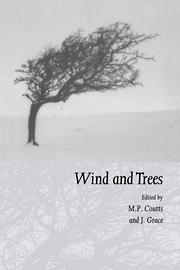Book contents
- Frontmatter
- Contents
- Preface
- List of contributors
- Part I Airflow over topography and in forests
- 1 Turbulent airflow in forests on flat and hilly terrain
- 2 The interactions of wind and tree movement in forest canopies
- 3 Edge effects on diffusivity in the roughness layer over a forest
- 4 A wind tunnel study of turbulent airflow in forest clearcuts
- 5 Testing of a linear airflow model for flow over complex terrain and subject to stable, structured stratification
- 6 Predicting windspeeds for forest areas in complex terrain
- Part II Mechanics of trees under wind loading
- Part III Tree physiological responses
- Part IV Impacts of wind on forests and ecology
- Part V Risk assessment and management response
- Index
2 - The interactions of wind and tree movement in forest canopies
Published online by Cambridge University Press: 27 October 2009
- Frontmatter
- Contents
- Preface
- List of contributors
- Part I Airflow over topography and in forests
- 1 Turbulent airflow in forests on flat and hilly terrain
- 2 The interactions of wind and tree movement in forest canopies
- 3 Edge effects on diffusivity in the roughness layer over a forest
- 4 A wind tunnel study of turbulent airflow in forest clearcuts
- 5 Testing of a linear airflow model for flow over complex terrain and subject to stable, structured stratification
- 6 Predicting windspeeds for forest areas in complex terrain
- Part II Mechanics of trees under wind loading
- Part III Tree physiological responses
- Part IV Impacts of wind on forests and ecology
- Part V Risk assessment and management response
- Index
Summary
Abstract
The response of four trees to wind loading in a dense spruce plantation has been investigated. Tree movement is well correlated with the passage of coherent gusts over the forest which can be identified by applying the variable-interval time-averaging (VITA) method to the momentum flux signal within the canopy. The gusts are relatively long lived but with a small spatial scale (˜1 tree height). The trees do not resonate with turbulent wind components close to their natural frequency but behave like damped harmonic oscillators responding to the intermittent impulsive loading during gust passage. The presence of trees severely modifies the turbulence spectra within the canopy by short-circuiting the normal energy cascade process and this may be an adaptive strategy developed by trees to efficiently lose energy absorbed from the wind.
Introduction
Strong winds associated with Atlantic depressions in Northern Europe, hurricanes in North America and the Caribbean or cyclones in Japan, New Zealand and the Pacific Islands cause extensive damage to forests world-wide every year (Savill, 1983). Considerable research has been carried out to understand the physical processes involved in order to improve silvicultural practices and to predict better the likelihood of damage.
It was soon realised that trees blow down at windspeeds considerably lower than those predicted from static pulling tests under calm conditions (Fraser & Gardiner, 1967; Oliver & Mayhead, 1974; Blackburn & Petty, 1988). One explanation is that trees are dynamic structures capable of resonating at their natural sway frequency with the turbulent wind field.
- Type
- Chapter
- Information
- Wind and Trees , pp. 41 - 59Publisher: Cambridge University PressPrint publication year: 1995
- 57
- Cited by

